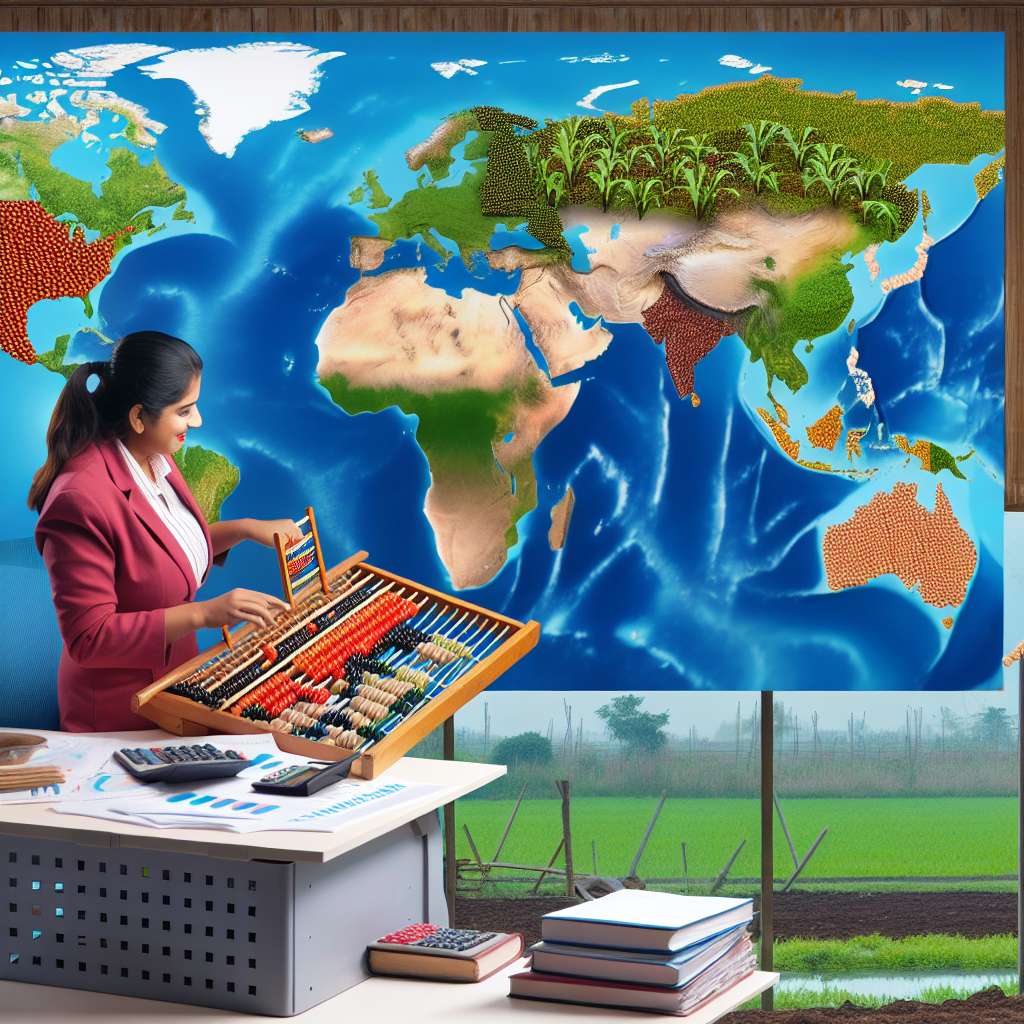Introduction to Tariffs
Definitions and Basic Concepts
Tariffs represent taxes imposed on imported goods.
They influence the price and availability of products in a country.
Governments utilize tariffs to regulate trade policies.
This mechanism serves as a tool to protect local industries.
Moreover, tariffs can help generate revenue for governments.
The Purpose of Tariffs
Fostering domestic production is one key purpose of tariffs.
By making imports more expensive, tariffs encourage consumers to buy local.
This approach aims to boost national economic growth.
Additionally, tariffs can help stabilize domestic markets.
They work to reduce the risk of market volatility.
Types of Tariffs
There are several types of tariffs globally.
Ad valorem tariffs are based on the value of goods.
Specific tariffs are fixed fees based on quantity or weight.
Finally, compound tariffs combine both types.
Each type serves different economic strategies and impacts markets differently.
Transform Your Agribusiness
Unlock your farm's potential with expert advice tailored to your needs. Get actionable steps that drive real results.
Get StartedChallenges and Criticisms of Tariffs
Tariffs can create conflicts between nations.
They may provoke retaliatory measures, escalating trade wars.
Moreover, tariffs might lead to higher prices for consumers.
Local industries benefiting from protection could become complacent.
This complacency may stifle innovation and competitiveness.
Historical Overview of Agricultural Tariffs: A Global Perspective
The Origins of Agricultural Tariffs
Agricultural tariffs began as a tool for governments to protect domestic industries.
Countries introduced these tariffs to promote local production.
Initially, nations like England and France utilized tariffs after the Industrial Revolution.
Throughout the 19th century, many countries followed suit.
The Rise of Protectionism
The early 20th century marked a significant rise in protectionist policies.
Countries faced economic instability and sought to shield local farmers.
In the United States, the Fordney-McCumber Tariff Act increased duties on imported goods.
This act aimed to support American agriculture amid global competition.
Global Trade Agreements and Their Impact
Following World War II, nations focused on rebuilding economies through trade agreements.
Organizations like the General Agreement on Tariffs and Trade (GATT) emerged.
These agreements sought to reduce tariffs and facilitate international trade.
Despite these efforts, agricultural tariffs remained contentious in negotiations.
The Modern Era of Tariffs
The late 20th century saw a shift in tariff strategies.
Countries began to reassess how tariffs affect agriculture on a global scale.
Developing nations often faced higher barriers that limited their agricultural exports.
This led to calls for more equitable tariff systems.
A Case Study: The European Union’s Common Agricultural Policy
The European Union introduced the Common Agricultural Policy (CAP) to support its farming sector.
CAP aimed to stabilize markets, boost farmer incomes, and ensure food security.
Through direct payments and tariffs, the EU sought to balance its agricultural market.
Showcase Your Farming Business
Publish your professional farming services profile on our blog for a one-time fee of $200 and reach a dedicated audience of farmers and agribusiness owners.
Publish Your ProfileHowever, this led to criticisms from non-EU countries regarding inequities.
Current Challenges and Future Considerations
Today, agricultural tariffs continue to play a crucial role in global markets.
Current debates focus on balancing protectionism with free trade principles.
With climate change and food security at stake, nations must adapt their tariff strategies.
Innovative approaches will be necessary to create a sustainable agricultural system.
The Economic Impact of Tariffs on Domestic Agricultural Markets
Introduction to Tariffs
Tariffs serve as a crucial tool in international trade policy.
Governments impose them to protect domestic industries.
They specifically impact agricultural markets significantly.
Effects on Domestic Prices
Tariffs can raise the prices of imported agricultural products.
Consequently, domestic producers may gain a competitive advantage.
Higher prices can help local farmers improve their incomes.
However, this also leads to increased costs for consumers.
Market Access and Trade Relationships
Tariffs influence the accessibility of international markets.
Countries implementing tariffs may face retaliation.
Such responses can limit market opportunities for exporters.
Ultimately, strained trade relationships affect global supply chains.
Impact on Production and Investment
Tariffs can affect agricultural production decisions.
Farmers might scale up production in response to higher prices.
Investments may concentrate in sectors protected by tariffs.
However, overreliance on tariffs can stifle innovation.
Long-term Consequences
Relying on tariffs can lead to economic inefficiencies.
Domestic market protection may reduce competitiveness globally.
In the long run, this strategy can deter foreign investment.
Ultimately, agricultural markets may struggle to adapt.
Explore Further: Key Trade Agreements That Influence Modern Farming Practices
Case Studies of Major Agricultural Tariffs in Different Countries
United States Tariff Policies
The United States implements various tariffs on agricultural products.
These tariffs aim to protect domestic farmers from international competition.
For example, the U.S. imposes tariffs on sugar imports.
This practice supports local sugar producers.
However, it leads to higher prices for consumers.
In addition, these tariffs affect trade relations with other countries.
European Union Agricultural Tariffs
The European Union (EU) maintains a Common Agricultural Policy (CAP).
This policy includes several protective tariffs on agricultural imports.
One significant area is dairy products.
The EU heavily regulates dairy tariffs to safeguard its farmers.
Consequently, this creates trade tensions with non-EU countries.
Trade agreements often focus on reducing these tariffs.
India’s Agricultural Tariff Strategies
India has a complex system of agricultural tariffs.
These tariffs protect farmers from fluctuations in global markets.
For instance, pulses face high import duties.
Showcase Your Farming Business
Publish your professional farming services profile on our blog for a one-time fee of $200 and reach a dedicated audience of farmers and agribusiness owners.
Publish Your ProfileThis encourages domestic production of legumes.
Moreover, India uses tariffs to manage its rice and wheat trade.
Such policies have sparked debates about self-sufficiency versus global trade.
Brazil’s Approach to Tariffs
Brazil offers a contrasting view on agricultural tariffs.
The country favors low tariffs to boost agricultural exports.
For example, Brazilian soybeans benefit from minimal import barriers.
This approach enhances Brazil’s competitiveness in global markets.
However, it puts pressure on local farmers facing subsidized imports.
Balancing global competitiveness with local needs remains a challenge.
China’s Tariff Response to Trade Wars
China’s agricultural tariffs have risen in response to trade wars.
For instance, tariffs on U.S. soybeans dramatically increased.
This decision directly impacts global soybean prices.
China seeks to minimize reliance on imports from the U.S.
As a result, it invests more in local soybean production.
However, tensions between nations complicate future trade agreements.
Impact of Global Tariff Policies
Global tariff policies shape agricultural market dynamics significantly.
They influence pricing, supply chains, and consumer choices worldwide.
Moreover, shifting tariffs can create market volatility.
Farmers adapt strategies based on current trade regulations.
Consumers often face the consequences through fluctuating prices.
Understanding these case studies reveals the complexities of global agriculture.
Delve into the Subject: Understanding Pesticide Registration Processes
The Role of Tariffs in Protecting Local Farmers and Industries
Importance of Tariffs
Tariffs play a significant role in agriculture by protecting local farmers.
They create a price advantage for domestic products over imports.
This reduces competition from foreign producers.
Consequently, farmers can maintain their market share.
Tariffs also encourage local production, which boosts the economy.
They help stabilize prices for domestic agricultural products.
Impact on Local Industries
Increased tariffs can lead to higher prices for imported goods.
This, in turn, protects local agribusinesses from market fluctuations.
Families that rely on agricultural jobs benefit from these protective measures.
Moreover, local industries can invest more in innovation and growth.
This strengthens the overall agricultural sector in a nation.
Case Studies and Examples
For instance, the U.S. imposed tariffs on certain agricultural imports.
This action aimed to support American farmers during economic downturns.
Another example is the European Union’s Common Agricultural Policy.
This policy utilizes tariffs to protect local farmers from global competition.
Such measures have proven beneficial in maintaining agricultural viability.
Challenges and Criticisms
However, tariffs can also have drawbacks.
They may lead to retaliatory measures from other countries.
Showcase Your Farming Business
Publish your professional farming services profile on our blog for a one-time fee of $200 and reach a dedicated audience of farmers and agribusiness owners.
Publish Your ProfileSuch actions can escalate into trade wars that harm all parties.
Additionally, consumers may face higher prices for goods.
This may limit access to a variety of agricultural products.
Learn More: Understanding the Connection Between Rural Policies and Farming

Tariffs and International Trade Agreements: Balancing Protection and Free Trade
Understanding Tariffs
Tariffs are taxes imposed on imported goods.
They serve multiple purposes in international trade.
Primarily, tariffs aim to protect domestic industries.
Additionally, they generate revenue for governments.
Moreover, tariffs can influence consumer behavior and market prices.
The Role of Tariffs in Agricultural Markets
Agricultural sectors are significantly affected by tariffs.
They can either shield local farmers or create market distortions.
Countries often use tariffs to boost domestic agriculture.
However, high tariffs can lead to retaliation from trading partners.
This retaliation may further complicate international relations.
Trade Agreements and Tariff Reductions
Trade agreements often include provisions for tariff reductions.
These agreements facilitate access to foreign markets.
For instance, agreements like NAFTA transformed North American trade.
These changes benefit consumers through lower prices.
However, they can hurt certain domestic industries as well.
Finding a Balance
Countries must balance protectionism and free trade principles.
A strategic approach can foster local development while remaining competitive.
Negotiating terms that benefit all parties is crucial.
Flexible tariff structures can adapt to changing market conditions.
Ultimately, the goal is to enhance food security and economic stability.
See Related Content: How Import Export Policies Affect Crop Prices And Farming
The Effects of Tariffs on Global Food Prices and Supply Chains
Impact on Food Prices
Tariffs significantly influence global food prices.
For instance, when a country imposes tariffs, prices for imported goods rise.
This price increase affects consumers and producers alike.
As a result, consumers may pay more for staple foods.
On the other hand, local producers may benefit from reduced competition.
However, elevated food prices can also lead to inflation in the economy.
For example, in 2018, U.S. tariffs on China escalated food prices.
Such price hikes impact low-income families disproportionately.
Consequently, food security becomes a pressing concern.
Effects on Supply Chains
Tariffs create disruptions in global supply chains.
Many agricultural products rely on international trade networks.
When tariffs are introduced, logistics become more complex.
For example, importers must navigate higher prices and adjusted supplier relationships.
This adjustment often delays product availability in retail markets.
Furthermore, producers may seek new markets to offset losses.
Showcase Your Farming Business
Publish your professional farming services profile on our blog for a one-time fee of $200 and reach a dedicated audience of farmers and agribusiness owners.
Publish Your ProfileConsequently, this leads to a realignment of sourcing strategies.
In response, companies may invest in local sourcing to mitigate risks.
Optimizing supply chains becomes essential for maintaining profitability.
Market Reactions and Adjustments
Markets react dynamically to tariff changes.
Producers adjust their outputs based on prevailing tariffs.
For instance, when tariffs increase, many may reduce production.
Alternatively, some producers expand to alternative markets.
This flexibility often dictates their long-term viability.
Tariffs can spur innovation within agricultural sectors.
For example, farmers may adopt new technologies to cut costs.
This proactive approach helps them compete amidst tariff challenges.
Ultimately, the adaptability of the agricultural market remains crucial.
Future Trends: The Evolution of Tariffs in Response to Climate Change and Globalization
Understanding the Impact of Climate Change
Climate change significantly affects agricultural productivity worldwide.
As weather patterns shift, the reliability of crop yields diminishes.
Consequently, governments must adapt trade policies to support farmers.
Tariffs can serve as a protective measure for local industries facing climate challenges.
For instance, higher tariffs on imported crops might incentivize domestic production.
The Role of Globalization in Agricultural Markets
Globalization has interconnected agricultural markets around the globe.
It facilitates the exchange of goods, technology, and practices.
However, this interdependence poses challenges to local markets.
To mitigate risks, countries are reconsidering their tariff structures.
Increased tariffs can protect local farmers from foreign competition.
Emerging Policies and Tariff Strategies
Countries are exploring innovative tariff strategies to adapt to ongoing changes.
Zero tariffs on sustainable products encourage eco-friendly agricultural practices.
On the other hand, protecting fledgling industries requires strategic tariff increases.
Moreover, some nations are emphasizing regional trade agreements to enhance cooperation.
These agreements often include provisions addressing climate resilience.
Future Considerations for Agricultural Tariffs
The relationship between tariffs and agricultural sustainability is evolving.
Policymakers must balance protecting local farmers with promoting free trade.
Collaborative international approaches may emerge as critical solutions.
Additionally, adapting tariffs based on environmental criteria may gain traction.
Ultimately, the future of agriculture hinges on adaptive tariff strategies amid changing global dynamics.




